In the Food and Beverage sector in general, Fast Casual, Café’s, and QSRs have been adapting to COVID-19. Many of these practices, in fact, can be adapted even in international markets like Seoul, South Korea.
As in many countries, dine-in has continued to see waves of push back. In some cases, we have seen new dine-in measures put in place only to have a spike in COVID-19 cases force local governments to again limit dine-in.
That said, many customers are also wary of COVID and have elected to either not dine inside or weather permitting sit outside. The latter has worked fine for summer and fall dining in many markets, but with cold winter weather, it may not be an option.
So, what are some of the best practices?
One. Early on amid COVID-19 restrictions, F&B brands who moved fast to contactless drive-thru have done well. In fact, a number of brands like America’s Chick-fil-A added additional drive-thru lines to cope with the volume of new business.
What I find as revealing is even months after we’ve seen restrictions rolled back a number of QSR have opted out of offering their dine-in option. Overall, we’ve seen a smart best practice is to add a drive-thru or even double the number of drive-thru lanes — the costs being well worth the investment.
For example, Taco Bell’s newest restaurant design emphasizes the drive-thru and limits human interaction, making it more suitable for the coronavirus era. Taco Bell is cutting back on dining room seating and adding a second drive-thru lane dedicated to pick-up orders made on its app.
Two. As many store locations were and may be without a drive-thru option, curbside service has worked well, too. This includes special curbside pick-up spaces and designated spots to stand outside while your order is being prepared and walked out to you.
Three. Pick up options. With remote online ordering and in-store kiosks, another great option has been contactless in-store pickup. Like in the past, as we’ve seen with pre-COVID Starbucks where one can order via the ap, then swing by a location and grab and go…many brands have now instituted similar contactless services — with a designated and numbered rack for self-pickup.
Four. Delivery. Although a growing segment in the past few years — home delivery has boomed. With an Online or phone order, meals are dropped off. Your orders are hassle-free and contactless.
Five. And finally, a shift to healthy alternatives. It is no surprise we have seen a demand for healthy alternatives. A case in point is Utah based, Roxberry Juice that saw strong growth in sales they attribute to concerns over health — many now seeing the importance of maintaining a nutritious and vitamin-packed diet.
All in all, and as I’ve seen in travel both across America and in Korea when visiting drive-thrus, using curbside, or in-store kiosks, the brands that do the best are those who recognize that even when wearing masks and social distancing that customer service still matters. In fact, providing a great customer experience, whether Singapore, Denver, London, or Seoul, amid COVID is perhaps the best global advice.
###
Don Southerton writes and speaks frequently on Korea and business-related topics such as the Korean Food and Beverage market. He is currently Korea Representative for a number of Western fast casual and QSR.

No comments:
Post a Comment